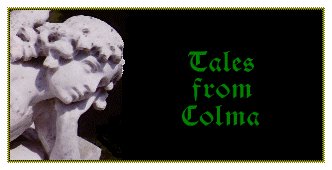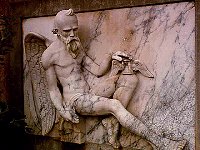
The Murder and Afterlife
of Senator David Broderick
Part Three
by Joel GAzis-SAx
Copyright 1996 by Joel GAzis-SAx



Leonidas Haskell had built his house on land owned by the Government. In 1863, he and other Black Point squatters were ordered to leave their houses by a court. The military moved in and built Fort Mason, using the abandoned Victorians as officer's quarters.
The Haskell House developed a reputation as being haunted. Occupants spoke of a man in a long black coat and a top hat walking through the rooms of the house as if he were thinking. This, many thought, was the ghost of Senator David Broderick. In more recent times (1975-77), an Army colonel who lived in the house reported "I feel that something or someone follows me about the house at times. I even feel that it watches me in the shower."
Bay Area psychic Sylvia Brown claimed to have seen "Black people...hidden in the cellar". Antoinette May excitedly points to the probability that Haskell was an abolitionist who was part of the Underground Railroad, but this is doubtful.¹ California was not on the Underground Railroad due to its far Western location. Few if any runaway slaves left the South to arrive in California. Heizer and Almquist note that California's fugitive slave laws were not designed to return runaways, but to allow slave-owners to continue retaining their property during their "visits" to the state.² It seems that May's imprimateur on Brown's experience is nothing more than enthusiasm informed by a incomplete knowledge of history.
Nonetheless, it is clear that the murder of Senator Broderick continues to excite the imaginations of the people of San Francisco. The site of the duel is a state landmark where the positions of each of the combatants is marked. The Haskell House is now part of the Golden Gate National Recreation Area and bears a sign testifying to the role as the site of the Senator's death. Downtown, in The Museum of Money (run by a prominent local bank), the French pistols which were used in the duel remain on display.
The current official view on Broderick is that he was a corrupt politician sanctified by his martyr's death at the hands of Terry. This aspersion is drawn because of Broderick's Tammany training. We must, for a moment, consider the reason for this hostility: Tammany was, indeed, an institution riddled with corrupt individuals, but it was also the most effective workingman's political organization of its time. It served the needs of the people it alledgedly exploited and opposed the designs of those who had come by their money through inheiritance or toil-free investments. It allowed a workingman like Broderick to become self-educated and attain the rank of Senator. Broderick, we should note, won his California position without Tammany support (which was a railroadless continent away). If America respects self-made men, then Broderick certainly deserves our respect for what he did in life, not just for the manner in which he died.
When elite histories refuse to acknowledge the accomplishments of men like Broderick, the common people tell tales. If Senator Broderick's courage in life, aside from those few seconds facing Terry in the sand, is forgotten or glossed over, then the instinct appears to be to grant him a new courage and a new triumph. As a ghost, Broderick had successfully challenged death itself. The Judge had destroyed his body, but not his presence in this world. A ghost, after all, is a spirit, of the same class of creature as "Liberty Leading the People" or Goya's monsters in his "Fortunes of War" series. Tales of ghosts are often associated with bloodshed and injustice:
Residents of the Haskell House hear the Senator's footsteps in the creaking of the old boards and feel his presence in the variable atmospheres of the house's nooks and corners because he lives as a testament to the horrors of the 1850s, to a time when a faction sought to force its will through corruption and violence upon the nation. Several duels were fought in California over the Kansas question. In each one of them, the Southern Chivalrist killed his opponent. None were prosecuted. Broderick walks in our imaginations to remind us that in life as well as death, he stood for popular representation. He spoke for the people who used their hands to create the monuments by which the smooth-skinned and clean-handed elite of this nation sought to commemorate themselves and to dig out the gold by which these same elites enriched themselves. The loud reports of his steps toll the injustices of his time, each crack reminding us of those who were killed in defense of government by the people.

Broderick was buried in San Francisco's Laurel Hill Cemetery atop Lone Mountain. The people of California erected a monument to his memory there. As the City of San Francisco expanded from the Bay to the Pacific, real estate speculators began to covet its grounds and local juvenile delinquents used them as a revel ground. Stories of desecrated graves, child molesters, and skulls kicked as footballs abound. Beginning in the 1880s, San Francisco citizens looked to the small farming community of Colma as the fields in which they buried their dead.  Many families moved their deceased to these plots. In 1914, the City and County of San Francisco Board of Supervisors voted to close most of the city's existing cemeteries.
Many families moved their deceased to these plots. In 1914, the City and County of San Francisco Board of Supervisors voted to close most of the city's existing cemeteries.
The trustees of Laurel Hill Cemetery resisted this move until 1940 when popular votes and court orders forced them to join in the migration to Colma. Thousands of graves were exhumed and moved to special vaults beneath a mound in Cypress Lawn Cemetery. A stone obelisk was erected over the mound. A bronze statue, commemorating those pioneers who came overland, was commissioned. And near the base of the obelisk, on the back side of a stone upon which was inscribed the story of Laurel Hill Cemetery, a magnificent piece of stonecutter's art shows Father Time in repose. Broderick would be pleased with this work, if he could see it. He would be proud to have such a monument over his grave, if he is buried there.
When laborers moved aside the monument which the people of California had placed in Broderick's memory, they found nothing beneath it. There was no evidence that anyone had ever been buried at that spot. Of course, Broderick's body could have fallen to many fates. The most plausible of these is that the caretakers of his time were merely sloppy in their accounting and placed the monument where it would be most prominent. Ah, but the rich mystery of it all! The imagination reels with the possibilities. Was Broderick not killed in the duel? Did he walk away in death? Was his body stolen or hidden from thieves who might desecrate it? The stone atop the Laurel Hill Mound tells us nothing. On its bleak surface, we make embellishments to suit our sense of rage and pride.

